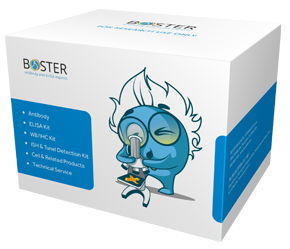Product Info Summary
| SKU: | A00731-2 |
|---|---|
| Size: | 100 μg/vial |
| Reactive Species: | Human, Mouse, Rat |
| Host: | Rabbit |
| Application: | ELISA, IHC, WB |
Customers Who Bought This Also Bought
Product info
Product Name
Anti-MRE11/MRE11 Antibody Picoband®
SKU/Catalog Number
A00731-2
Size
100 μg/vial
Form
Lyophilized
Description
Boster Bio Anti-MRE11/MRE11 Antibody Picoband® catalog # A00731-2. Tested in ELISA, IHC, WB applications. This antibody reacts with Human, Mouse, Rat. The brand Picoband indicates this is a premium antibody that guarantees superior quality, high affinity, and strong signals with minimal background in Western blot applications. Only our best-performing antibodies are designated as Picoband, ensuring unmatched performance.
Storage & Handling
Store at -20˚C for one year from date of receipt. After reconstitution, at 4˚C for one month. It can also be aliquotted and stored frozen at -20˚C for six months. Avoid repeated freeze-thaw cycles.
Cite This Product
Anti-MRE11/MRE11 Antibody Picoband® (Boster Biological Technology, Pleasanton CA, USA, Catalog # A00731-2)
Host
Rabbit
Contents
Each vial contains 4mg Trehalose, 0.9mg NaCl, 0.2mg Na2HPO4, 0.05mg NaN3.
Clonality
Polyclonal
Isotype
Rabbit IgG
Immunogen
E. coli-derived human MRE11 recombinant protein (Position: S2-D239).
*Blocking peptide can be purchased. Costs vary based on immunogen length. Contact us for pricing.
Cross-reactivity
No cross-reactivity with other proteins.
Reactive Species
A00731-2 is reactive to MRE11 in Human, Mouse, Rat
Reconstitution
Add 0.2ml of distilled water will yield a concentration of 500ug/ml.
Observed Molecular Weight
81 kDa
Calculated molecular weight
80.593kDa
Background of MRE11
Double-strand break repair protein MRE11A is a protein that in humans is encoded by the MRE11A gene. This gene encodes a nuclear protein involved in homologous recombination, telomere length maintenance, and DNA double-strand break repair. By itself, the protein has 3' to 5' exonuclease activity and endonuclease activity. The protein forms a complex with the RAD50 homolog; this complex is required for nonhomologous joining of DNA ends and possesses increased single-stranded DNA endonuclease and 3' to 5' exonuclease activities. In conjunction with a DNA ligase, this protein promotes the joining of noncomplementary ends in vitro using short homologies near the ends of the DNA fragments. This gene has a pseudogene on chromosome 3. Alternative splicing of this gene results in two transcript variants encoding different isoforms.
Antibody Validation
Boster validates all antibodies on WB, IHC, ICC, Immunofluorescence, and ELISA with known positive control and negative samples to ensure specificity and high affinity, including thorough antibody incubations.
Application & Images
Applications
A00731-2 is guaranteed for ELISA, IHC, WB Boster Guarantee
Assay Dilutions Recommendation
The recommendations below provide a starting point for assay optimization. The actual working concentration varies and should be decided by the user.
Western blot, 0.1-0.5μg/ml
Immunohistochemistry (Paraffin-embedded Section), 0.5-1μg/ml
ELISA, 0.1-0.5μg/ml
Positive Control
WB: human Hela whole cell, human MCF-7 whole cell, human COLO-320 whole cell, human U-87MG whole cell, rat brain tissue, rat liver tissue, mouse brain tissue, mouse liver tissue
IHC: human colon cancer tissue, human lung cancer tissue, human mammary cancer tissue
Validation Images & Assay Conditions
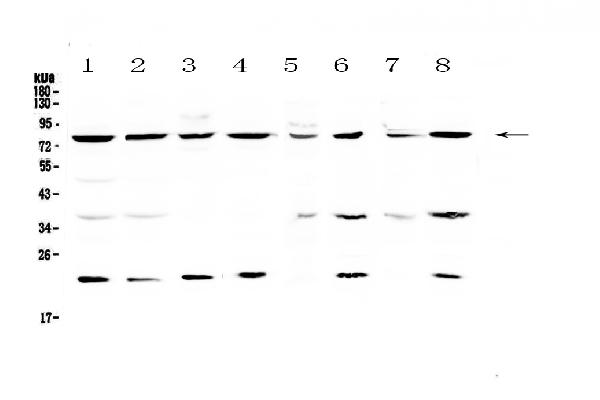
Click image to see more details
Figure 1. Western blot analysis of MRE11 using anti-MRE11 antibody (A00731-2).
Electrophoresis was performed on a 5-20% SDS-PAGE gel at 70V (Stacking gel) / 90V (Resolving gel) for 2-3 hours. The sample well of each lane was loaded with 50ug of sample under reducing conditions.
Lane 1: human Hela whole cell lysates,
Lane 2: human MCF-7 whole cell lysates,
Lane 3: human COLO-320 whole cell lysates,
Lane 4: human U-87MG whole cell lysates,
Lane 5: rat brain tissue lysates,
Lane 6: rat liver tissue lysates,
Lane 7: mouse brain tissue lysates,
Lane 8: mouse liver tissue lysates.
After Electrophoresis, proteins were transferred to a Nitrocellulose membrane at 150mA for 50-90 minutes. Blocked the membrane with 5% Non-fat Milk/ TBS for 1.5 hour at RT. The membrane was incubated with rabbit anti-MRE11 antigen affinity purified polyclonal antibody (Catalog # A00731-2) at 0.5 μg/mL overnight at 4°C, then washed with TBS-0.1%Tween 3 times with 5 minutes each and probed with a goat anti-rabbit IgG-HRP secondary antibody at a dilution of 1:10000 for 1.5 hour at RT. The signal is developed using an Enhanced Chemiluminescent detection (ECL) kit (Catalog # EK1002) with Tanon 5200 system. A specific band was detected for MRE11 at approximately 81KD. The expected band size for MRE11 is at 81KD.
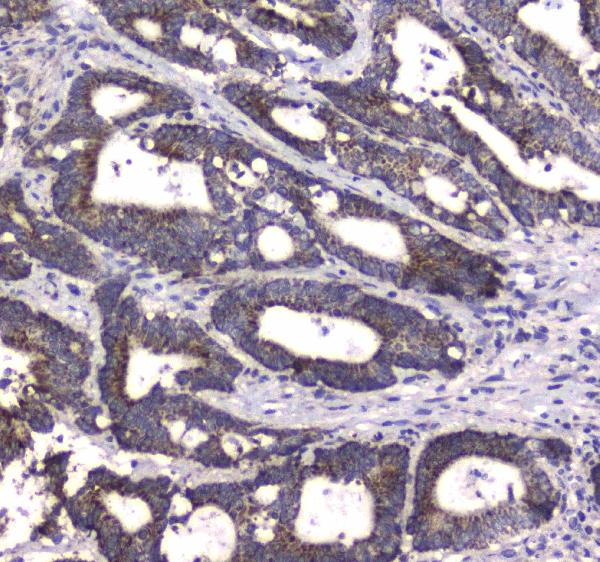
Click image to see more details
Figure 2. IHC analysis of MRE11 using anti-MRE11 antibody (A00731-2).
MRE11 was detected in paraffin-embedded section of human colon cancer tissue. Heat mediated antigen retrieval was performed in citrate buffer (pH6, epitope retrieval solution) for 20 mins. The tissue section was blocked with 10% goat serum. The tissue section was then incubated with 1μg/ml rabbit anti-MRE11 Antibody (A00731-2) overnight at 4°C. Biotinylated goat anti-rabbit IgG was used as secondary antibody and incubated for 30 minutes at 37°C. The tissue section was developed using Strepavidin-Biotin-Complex (SABC)(Catalog # SA1022) with DAB as the chromogen.
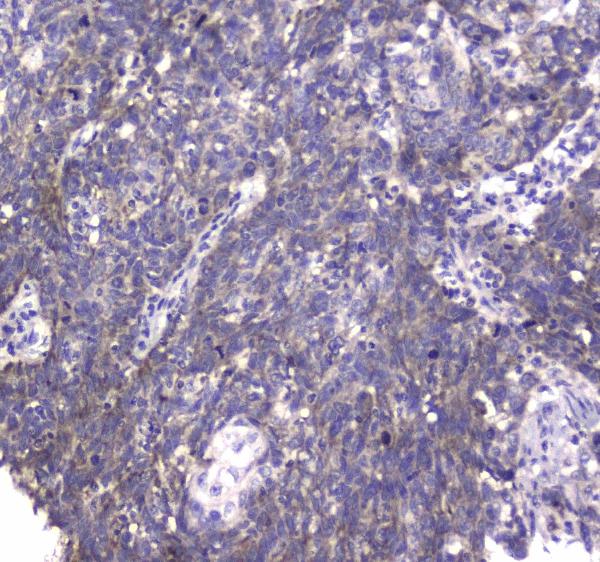
Click image to see more details
Figure 3. IHC analysis of MRE11 using anti-MRE11 antibody (A00731-2).
MRE11 was detected in paraffin-embedded section of human lung cancer tissue. Heat mediated antigen retrieval was performed in citrate buffer (pH6, epitope retrieval solution) for 20 mins. The tissue section was blocked with 10% goat serum. The tissue section was then incubated with 1μg/ml rabbit anti-MRE11 Antibody (A00731-2) overnight at 4°C. Biotinylated goat anti-rabbit IgG was used as secondary antibody and incubated for 30 minutes at 37°C. The tissue section was developed using Strepavidin-Biotin-Complex (SABC)(Catalog # SA1022) with DAB as the chromogen.
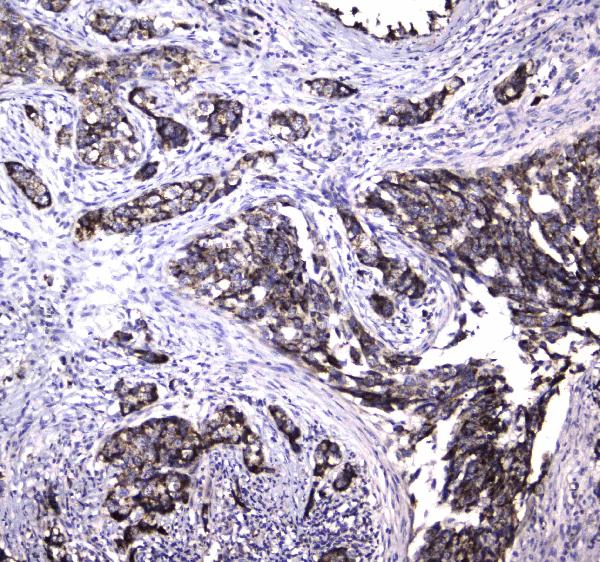
Click image to see more details
Figure 4. IHC analysis of MRE11 using anti-MRE11 antibody (A00731-2).
MRE11 was detected in paraffin-embedded section of human mammary cancer tissue. Heat mediated antigen retrieval was performed in citrate buffer (pH6, epitope retrieval solution) for 20 mins. The tissue section was blocked with 10% goat serum. The tissue section was then incubated with 1μg/ml rabbit anti-MRE11 Antibody (A00731-2) overnight at 4°C. Biotinylated goat anti-rabbit IgG was used as secondary antibody and incubated for 30 minutes at 37°C. The tissue section was developed using Strepavidin-Biotin-Complex (SABC)(Catalog # SA1022) with DAB as the chromogen.
Protein Target Info & Infographic
Gene/Protein Information For MRE11 (Source: Uniprot.org, NCBI)
Gene Name
MRE11
Full Name
Double-strand break repair protein MRE11
Weight
80.593kDa
Superfamily
MRE11/RAD32 family
Alternative Names
Double-strand break repair protein MRE11; Double-strand break repair protein MRE11A; Meiotic recombination 11 homolog 1; MRE11 homolog 1; Meiotic recombination 11 homolog A; MRE11 homolog A; MRE11 MRE11 ATLD, HNGS1A, MRE11B, MRE11 MRE11 homolog, double strand break repair nuclease double-strand break repair protein MRE11|AT-like disease|DNA recombination and repair protein|MRE11 double strand break repair nuclease A|MRE11 homolog 1|MRE11 homolog A, double strand break repair nuclease|MRE11 homolog, double strand break repair nuclease A|MRE11 meiotic recombination 11 homolog A|MRE11 meiotic recombination 11-like protein A|double-strand break repair protein MRE11A|endo/exonuclease Mre11|meiotic recombination 11 homolog 1|meiotic recombination 11 homolog A
*If product is indicated to react with multiple species, protein info is based on the gene entry specified above in "Species".For more info on MRE11, check out the MRE11 Infographic

We have 30,000+ of these available, one for each gene! Check them out.
In this infographic, you will see the following information for MRE11: database IDs, superfamily, protein function, synonyms, molecular weight, chromosomal locations, tissues of expression, subcellular locations, post-translational modifications, and related diseases, research areas & pathways. If you want to see more information included, or would like to contribute to it and be acknowledged, please contact [email protected].
Specific Publications For Anti-MRE11/MRE11 Antibody Picoband® (A00731-2)
Hello CJ!
No publications found for A00731-2
*Do you have publications using this product? Share with us and receive a reward. Ask us for more details.
Recommended Resources
Here are featured tools and databases that you might find useful.
- Boster's Pathways Library
- Protein Databases
- Bioscience Research Protocol Resources
- Data Processing & Analysis Software
- Photo Editing Software
- Scientific Literature Resources
- Research Paper Management Tools
- Molecular Biology Software
- Primer Design Tools
- Bioinformatics Tools
- Phylogenetic Tree Analysis
Customer Reviews
Have you used Anti-MRE11/MRE11 Antibody Picoband®?
Submit a review and receive an Amazon gift card.
- $30 for a review with an image
0 Reviews For Anti-MRE11/MRE11 Antibody Picoband®
Customer Q&As
Have a question?
Find answers in Q&As, reviews.
Can't find your answer?
Submit your question
1 Customer Q&As for Anti-MRE11/MRE11 Antibody Picoband®
Question
We are currently using anti-MRE11/MRE11 antibody A00731-2 for rat tissue, and we are happy with the IHC results. The species of reactivity given in the datasheet says human, mouse, rat. Is it likely that the antibody can work on primate tissues as well?
Verified Customer
Verified customer
Asked: 2018-10-11
Answer
The anti-MRE11/MRE11 antibody (A00731-2) has not been validated for cross reactivity specifically with primate tissues, though there is a good chance of cross reactivity. We have an innovator award program that if you test this antibody and show it works in primate you can get your next antibody for free. Please contact me if I can help you with anything.
Boster Scientific Support
Answered: 2018-10-11



